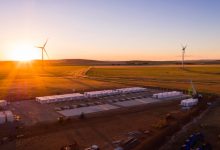The Tesla big battery in South Australia – officially known as the Hornsdale Power Reserve – delivered a windfall profit to its Paris-based owner Neoen in the first half of 2020, largely due to the key role it and other big batteries played when a massive storm blew down the state’s main link to Victoria.
The Hornsdale battery, along with another Tesla battery at Lake Bonney and the Dalrymple North battery, were asked to play a key role stabilising the South Australia grid during the 17 days that the state was “isolated” from the rest of the main grid, and it reaped a huge bonus in revenue and profits in return.
That key role delivered a one-off profit boost of €16.4 million ($A27 million) in the first half, allowing Neoen to more than treble its total earnings before interest and tax from battery storage to €23.2 million from €6.9 million, and contributed to a 58 per cent boost to overall earnings in the first half to €148.2 million.
The windfall returns from the latest half means that the Hornsdale battery has delivered total earnings (EBITDA) in it first two and a half years of operation of €54.4 million, which translates to $A88 million – for a battery that cost a little over $A90 million.
It’s important to remember also that the Hornsdale battery has delivered savings to consumers already estimated at more than $A150 million, and played key roles in keeping the lights on in a number of major network events. As we reported here: On first day as PM, Morrison learns difference between Big Battery and Big Banana.
The Hornsdale Power Reserve was the biggest lithium ion battery in the world when it was commissioned in 2017 with a capacity of 100MW/129MWh. It has now lost that world title despite recently finishing an expansion which lifts its capacity to 150MW/194MWh and add additional services such as inertia.
The expansion was completed this month – a few weeks late, the company noted in its earnings call with analysts – and is expected to start delivering those new inertia services in coming months under trials with the Australian Energy Market Operator. It will be the first battery of this scale to deliver such services.
Neoen does not expect a repeat of that windfall – unless, of course, another big storm blows down the main interconnector linking the two states – but has another two big batteries soon to be completed.
A 20/34MWh battery, also using Tesla Powerpacks, has been built at the Bulgana renewable energy hub in Victoria, alongside a 194MW wind farm. That project has been delayed by grid constraints in the north-west of Victoria, but is currently registered to operate at 100MW, and is now operating at 75MW, with full registration expected by the end of the year and full commissioning later this year or early next year.
Another big battery – 50MW with likely two hours of storage – will be built in Canberra as part of a long term contract with the ACT government that will also see the first 100MW stage of the massive Goyder South project in South Australia, that may one day host 900MW of wind, 600MW of solar, and 900MW/1800MWh of battery storage – 10 times bigger than the original Hornsdale battery.
The Canberra battery is expected to operate along similar lines to the Hornsdale Power Reserve, earning revenue from a mix of energy arbitrage, frequency control and ancillary services, and inertia.
The delays at Bulgana resulted in Neoen claiming liquidated damages from its contractor Siemens Gamesa, but CEO Xavier Barbaro said the damages cap had been reached, meaning any ongoing loss of revenue would be borne by Neoen.
“It’s not always easy to take (projects) from construction to connection,” Barbaro said in the earnings call.
Neoen booked a total of €33 million in gains from liquidated damages from contractors in charge of delayed projects in the latest half, up from €6 million in the same period last year, but did not break down the individual projects. It suggested that delayed solar projects in the US made up the bulk of that number.
 Neoen now has a number of major projects under construction, or about to start, in Australia. Apart from Goyder South and the Canberra big battery, it is also building a 400MW solar farm in the Western Downs of Queensland – Australia’s biggest – after landing a long term contract with CleanCo.
Neoen now has a number of major projects under construction, or about to start, in Australia. Apart from Goyder South and the Canberra big battery, it is also building a 400MW solar farm in the Western Downs of Queensland – Australia’s biggest – after landing a long term contract with CleanCo.
The Goyder South first stage has set the cheapest publicly announced power purchase agreement in Australia – equivalent to a little more than $35/MWh in current prices, or around half the prevailing wholesale price in NSW – and its Western Down solar project is believed to have delivered a similarly competitive outcome.
It also has a host of other projects in the pipeline, including a renewable energy hub at Kaban in Queensland, a massive wind and battery hub in a pine plantation in Victoria, and a 600MW Victoria big battery to boost the capacity of the main transmission link to NSW, and a host of other projects.
In the latest half year, Neoen said earnings from its solar portfolio in Australia were up €0.2 million, or one per cent, as an increase in capacity and gains from refinancing loans offset restrictions due to grid constraints and lower irradiation.
Wind earnings in Australia was down 32 per cent or €9 million due to constraints caused by the “islanding” – offsetting some of the gains from the battery – and the transfer of the Hornsdale 3 wind farm from merchant revenue to its less profitable fixed price contract with the ACT.










